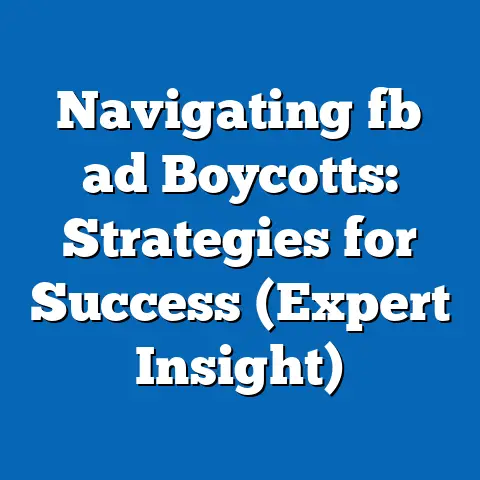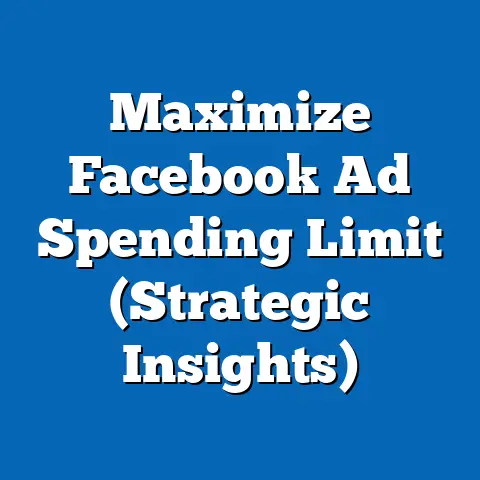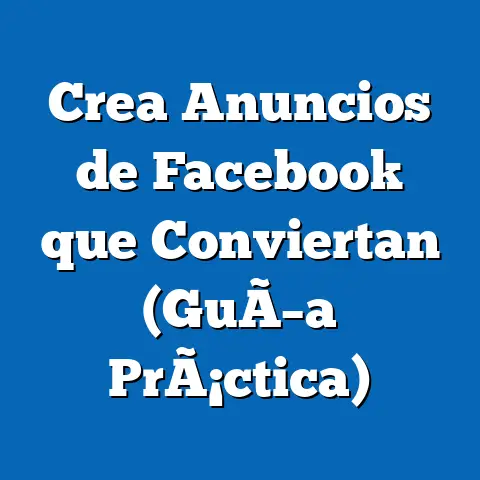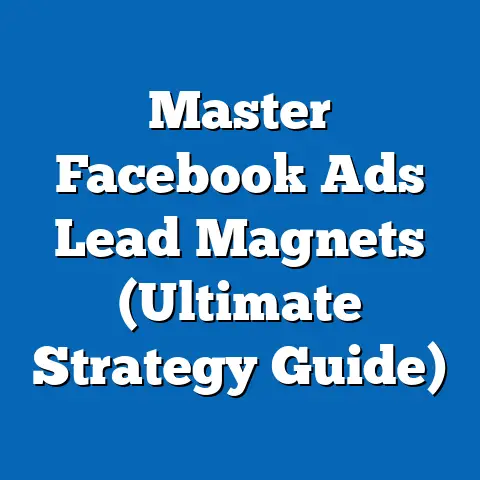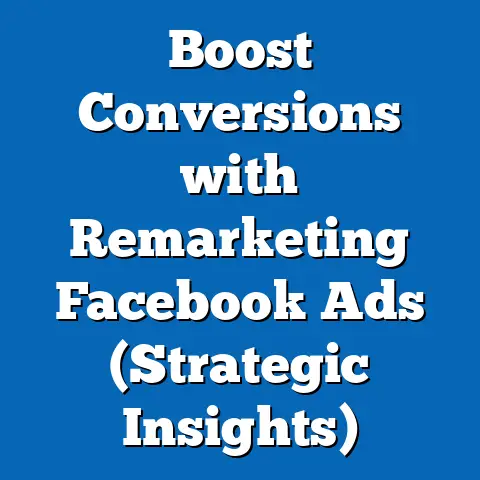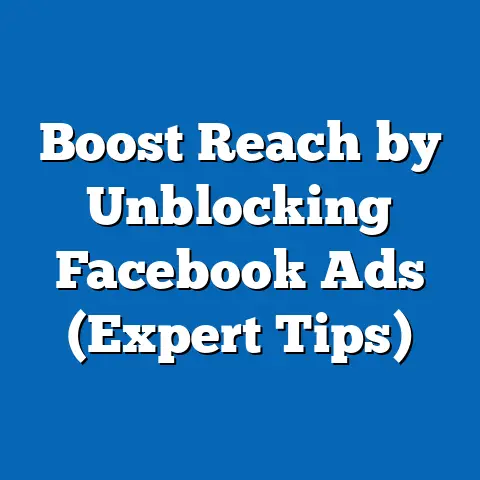Unlock Facebook Leads Ads API (Proven Growth Strategies)
Crafting a successful Facebook lead ad is akin to creating a piece of art. It requires a blend of creative design, data-driven strategy, and a deep understanding of your target audience. You’re not just throwing an ad out there; you’re carefully constructing a message that resonates with potential customers, drawing them in and converting them into valuable leads. In today’s digital marketing landscape, lead generation is the lifeblood of any thriving business. Facebook, with its massive user base and sophisticated targeting capabilities, offers unparalleled opportunities to connect with potential customers. But to truly unlock its potential, you need to harness the power of the Facebook Leads Ads API.
Facebook Leads Ads are a game-changer compared to standard ads. Instead of sending users to an external landing page, they allow you to collect information directly within the Facebook platform. This seamless experience drastically reduces friction, leading to higher conversion rates. Now, imagine automating and optimizing this process, tailoring your approach to perfection. That’s where the Facebook Leads Ads API comes in.
Understanding the Facebook Leads Ads API
Let’s dive into the heart of the matter: the Facebook Leads Ads API. What exactly is it, and why should you care?
What is the Facebook Leads Ads API?
In simple terms, the Facebook Leads Ads API is a programmatic interface that allows you to automate and manage your Facebook Lead Ads campaigns. Think of it as a set of instructions that allows your applications to interact directly with Facebook’s advertising platform. Instead of manually downloading leads and importing them into your CRM, the API can automate this process, saving you time and resources.
From a technical perspective, the API is a RESTful API, meaning it uses standard HTTP methods (GET, POST, PUT, DELETE) to interact with Facebook’s servers. This allows developers to easily integrate the API into their existing systems. The API provides endpoints for creating lead ads, retrieving lead data, managing leads, and much more.
The benefits of using the API are numerous:
- Automation: Automate the process of collecting and managing leads, freeing up your time for other tasks.
- Real-time Data: Access lead data in real-time, allowing you to follow up with leads immediately.
- Integration: Integrate the API with your CRM, marketing automation tools, and other systems for a seamless workflow.
- Scalability: Scale your lead generation efforts without the need for manual intervention.
- Optimization: Track and analyze your lead generation performance, allowing you to optimize your campaigns for better results.
I remember when I first started using the Leads Ads API. Before, I was manually downloading CSV files of leads and importing them into my CRM. It was a tedious and time-consuming process. Once I integrated the API, it was like a weight lifted off my shoulders. Leads were automatically synced with my CRM, allowing me to focus on nurturing those leads and closing deals.
How the API Works
Setting up and using the Facebook Leads Ads API may seem daunting at first, but it’s actually quite straightforward. Here’s a step-by-step explanation of how to get started:
-
Create a Facebook Developer Account: You’ll need a Facebook Developer account to access the API. You can create one at https://developers.facebook.com/.
-
Create an App: Once you have a developer account, create a new app. This app will be used to authenticate your requests to the API.
-
Get an Access Token: You’ll need an access token to authorize your API requests. There are different types of access tokens, but for most use cases, you’ll need a user access token with the
leads_retrievalpermission. You can obtain an access token using the Facebook Graph API Explorer. -
Set Up a Webhook: A webhook is a URL that Facebook will send lead data to in real-time. You’ll need to set up a webhook endpoint on your server to receive this data.
-
Subscribe to Lead Events: Once you have a webhook endpoint, you’ll need to subscribe to lead events for your Facebook Page. This tells Facebook to send lead data to your webhook whenever a new lead is generated.
-
Retrieve Lead Data: You can also retrieve lead data directly from the API using the
GETmethod. You’ll need to provide the lead ad ID and the access token.
Create a Facebook Developer Account: You’ll need a Facebook Developer account to access the API. You can create one at https://developers.facebook.com/.
Create an App: Once you have a developer account, create a new app. This app will be used to authenticate your requests to the API.
Get an Access Token: You’ll need an access token to authorize your API requests. There are different types of access tokens, but for most use cases, you’ll need a user access token with the leads_retrieval permission. You can obtain an access token using the Facebook Graph API Explorer.
Set Up a Webhook: A webhook is a URL that Facebook will send lead data to in real-time. You’ll need to set up a webhook endpoint on your server to receive this data.
Subscribe to Lead Events: Once you have a webhook endpoint, you’ll need to subscribe to lead events for your Facebook Page. This tells Facebook to send lead data to your webhook whenever a new lead is generated.
Retrieve Lead Data: You can also retrieve lead data directly from the API using the GET method. You’ll need to provide the lead ad ID and the access token.
Key functionalities of the API include:
- Creating Lead Ads: You can create new lead ads programmatically using the API. This allows you to automate the process of creating and launching new campaigns.
- Retrieving Lead Data: As mentioned earlier, you can retrieve lead data in real-time using webhooks or by making API requests.
- Managing Leads: The API also allows you to manage leads, such as marking them as qualified or disqualified.
- Customizing Lead Forms: The API enables you to customize your lead forms with specific questions and fields, ensuring you capture the information that’s most valuable to your business.
It’s important to note that the Facebook Leads Ads API is subject to Facebook’s advertising policies and terms of service. Make sure to review these policies carefully before using the API to ensure that you’re in compliance.
Integration with Other Tools
The real magic happens when you integrate the Facebook Leads Ads API with your other marketing tools. This allows you to create a seamless workflow that automates the entire lead generation process.
Here are some popular tools and platforms that work well with the API:
- CRM Systems: Integrating with CRM systems like Salesforce, HubSpot, and Zoho CRM allows you to automatically sync lead data with your customer database. This ensures that your sales team has access to the latest lead information. I personally use HubSpot, and the integration with the Leads Ads API has been a game-changer.
- Marketing Automation Tools: Integrating with marketing automation tools like Mailchimp, ActiveCampaign, and Marketo allows you to automatically send follow-up emails and nurture leads based on their behavior.
- Zapier: Zapier is a powerful integration platform that allows you to connect the Leads Ads API with thousands of other apps. This gives you the flexibility to create custom workflows that meet your specific needs.
- Google Sheets: For smaller businesses or those just starting out, integrating with Google Sheets can be a simple and effective way to manage lead data.
When choosing which tools to integrate with the Leads Ads API, consider your specific needs and budget. Start with the tools that will have the biggest impact on your lead generation process.
Takeaway: The Facebook Leads Ads API is a powerful tool that can automate and optimize your lead generation efforts. By understanding how the API works and integrating it with your other marketing tools, you can significantly improve your lead generation performance. Next, we’ll explore proven growth strategies using the Facebook Leads Ads API.
Proven Growth Strategies Using Facebook Leads Ads API
Now that we understand the basics of the Facebook Leads Ads API, let’s dive into some proven growth strategies that you can implement to maximize your lead generation efforts.
Strategy 1: Targeting the Right Audience
The foundation of any successful Facebook Ads campaign, including Leads Ads, is targeting the right audience. You can have the most compelling ad copy and visually stunning creatives, but if you’re showing your ads to the wrong people, you’re wasting your time and money.
Audience segmentation and targeting are crucial for successful lead generation. Facebook offers a wide range of targeting options, including:
- Demographics: Target users based on age, gender, location, education, and other demographic factors.
- Interests: Target users based on their interests, hobbies, and activities.
- Behaviors: Target users based on their online behavior, such as purchase history and website visits.
- Custom Audiences: Create custom audiences based on your existing customer data, such as email lists and website visitors.
- Lookalike Audiences: Create lookalike audiences based on your custom audiences. This allows you to target users who are similar to your existing customers.
Leveraging Facebook’s audience insights is key to identifying potential leads. The Audience Insights tool provides valuable information about your target audience, such as their demographics, interests, behaviors, and more. This information can help you refine your targeting and create more effective ad campaigns.
When creating custom and lookalike audiences, consider these tips:
- Start with a high-quality customer list: The more accurate and up-to-date your customer list, the better your custom and lookalike audiences will be.
- Segment your customer list: Segment your customer list based on different criteria, such as purchase history, demographics, and engagement level. This will allow you to create more targeted custom and lookalike audiences.
- Experiment with different seed audiences: Experiment with different seed audiences to see which ones generate the best results.
- Test different lookalike audience sizes: Facebook allows you to create lookalike audiences of different sizes. Test different sizes to see which one performs best.
- Refine your targeting over time: Monitor your campaign performance and refine your targeting based on the data you collect.
I’ve found that creating multiple custom and lookalike audiences, each targeting a specific segment of my target market, yields the best results. For example, I might create one custom audience based on my email list, another based on website visitors, and a third based on customers who have purchased a specific product.
Strategy 2: Crafting Compelling Ad Content
Once you’ve identified your target audience, the next step is to create compelling ad content that resonates with them. This includes both the visuals and the copy.
High-converting ad creatives typically include the following elements:
- Eye-catching visuals: Use high-quality images or videos that grab the user’s attention.
- Clear and concise copy: Use clear and concise language that quickly communicates the value proposition.
- Compelling headline: Use a headline that grabs the user’s attention and makes them want to learn more.
- Strong call to action: Use a strong call to action that tells the user what you want them to do.
- Relevance: Ensure that your ad content is relevant to your target audience and their interests.
I’ve seen countless campaigns succeed or fail based solely on the quality of the ad creatives. It’s worth investing the time and resources to create compelling visuals and copy that truly resonate with your target audience.
A/B testing is crucial for refining your ad content. Test different headlines, visuals, and calls to action to see which ones perform best. Facebook’s built-in A/B testing tool makes it easy to run these tests.
Here’s an example of how A/B testing can improve your ad performance:
- Original Ad: Headline: “Get a Free Consultation” Visual: Stock photo of a business meeting
- Variation A: Headline: “Transform Your Business Today” Visual: Before and after images of a successful client
- Variation B: Headline: “Limited Time Offer: Free Strategy Session” Visual: Video testimonial from a happy customer
After running an A/B test, you might find that Variation B performs significantly better than the original ad and Variation A. This data can then be used to optimize your ad content and improve your overall campaign performance.
The Leads Ads API can also be used to personalize ad content based on user data. For example, you can use the API to dynamically insert the user’s name or location into the ad copy. This can make your ads more relevant and engaging, leading to higher conversion rates.
Strategy 3: Optimizing Lead Forms
Here are some tips for designing user-friendly lead forms:
- Keep it short and simple: Only ask for the information you absolutely need. The longer the form, the lower the conversion rate.
- Use clear and concise labels: Make sure the labels for each field are clear and easy to understand.
- Use appropriate input types: Use appropriate input types for each field, such as text fields for names and email fields for email addresses.
- Provide helpful error messages: If a user enters invalid data, provide helpful error messages that tell them what they need to fix.
- Include a privacy policy: Include a link to your privacy policy so users know how their data will be used.
Mobile optimization is essential. Ensure that your lead forms are mobile-friendly and easy to fill out on a smartphone or tablet.
Reducing friction in the sign-up process is also crucial. Make it as easy as possible for users to provide their information. Consider using pre-filled fields to automatically populate the form with the user’s information.
Effective lead form questions yield high-quality leads. Ask questions that will help you qualify leads and identify their needs. For example, you might ask questions about their industry, company size, or budget.
Here are some examples of effective lead form questions:
- What is your biggest challenge in [relevant area]?
- What are your goals for [relevant area]?
- What is your budget for [relevant area]?
- What is your timeline for [relevant area]?
- What type of products or services are you interested in?
I often use a combination of open-ended and multiple-choice questions in my lead forms. Open-ended questions allow users to provide more detailed information, while multiple-choice questions are easier to answer and provide structured data.
Strategy 4: Nurturing Leads Post-Capture
Capturing a lead is only the first step. The real work begins after the lead has submitted their information. Nurturing leads post-capture is crucial for converting them into customers.
Email marketing is a powerful tool for engaging and nurturing leads. Send automated follow-up emails that provide valuable information, answer common questions, and offer exclusive deals.
Retargeting ads can also be used to nurture leads. Show targeted ads to leads who have visited your website or engaged with your content on Facebook.
Creating automated workflows that utilize the leads gathered through the API is essential for efficient lead nurturing. These workflows can be triggered by specific events, such as a lead submitting a form or visiting a particular page on your website.
Timely follow-ups and personalized communication are key. Respond to leads quickly and personalize your communication based on their individual needs and interests.
I’ve found that sending a personalized email within 24 hours of a lead submitting their information significantly increases the chances of converting that lead into a customer.
Strategy 5: Analyzing and Iterating on Performance
The final strategy is to track and analyze your ad performance metrics. This will help you identify what’s working and what’s not, and make adjustments to your campaigns accordingly.
Key performance indicators (KPIs) that marketers should focus on when using the Leads Ads API include:
- Cost per lead (CPL): The average cost of generating a lead.
- Conversion rate: The percentage of users who submit a lead form.
- Lead quality: The percentage of leads who are qualified and become customers.
- Return on ad spend (ROAS): The amount of revenue generated for every dollar spent on advertising.
Iterating on campaigns based on data insights is essential for continuous improvement. Regularly review your ad performance data and make adjustments to your targeting, ad content, and lead forms as needed.
The Leads Ads API can also be used to track custom conversion events. This allows you to track specific actions that leads take after submitting a form, such as visiting a particular page on your website or making a purchase.
I use a combination of Facebook’s built-in analytics tools and third-party analytics platforms to track my ad performance. This gives me a comprehensive view of my campaign performance and helps me identify areas for improvement.
Takeaway: These five strategies, when implemented effectively, can significantly improve your lead generation performance using the Facebook Leads Ads API. Remember to focus on targeting the right audience, crafting compelling ad content, optimizing lead forms, nurturing leads post-capture, and analyzing and iterating on performance.
Case Studies and Success Stories
To illustrate the power of the Facebook Leads Ads API, let’s take a look at some real-world case studies and success stories.
Case Study 1: Real Estate Agency
A real estate agency was struggling to generate leads using traditional marketing methods. They decided to try Facebook Leads Ads API to reach potential home buyers and sellers.
- Strategy: They created targeted ad campaigns that focused on specific neighborhoods and demographics. They used compelling visuals of beautiful homes and wrote ad copy that highlighted the benefits of working with their agency. They also optimized their lead forms to ask questions about the user’s budget, timeline, and desired location.
- Results: Within three months, the agency generated over 500 qualified leads and closed several deals. They saw a significant increase in their lead generation and revenue.
- Unique Approach: They used the Leads Ads API to integrate with their CRM system, which allowed them to automatically follow up with leads and track their progress.
Case Study 2: Software Company
A software company wanted to generate leads for their new product launch. They used Facebook Leads Ads API to reach potential customers in their target market.
- Strategy: They created targeted ad campaigns that focused on specific industries and job titles. They used video ads that showcased the features and benefits of their software. They also offered a free trial to users who submitted their information.
- Results: Within two months, the company generated over 1,000 qualified leads and saw a significant increase in their website traffic and sales.
- Unique Approach: They used the Leads Ads API to personalize their ad content based on the user’s industry and job title.
Case Study 3: E-commerce Business
An e-commerce business wanted to generate leads for their email marketing list. They used Facebook Leads Ads API to reach potential customers who were interested in their products.
- Strategy: They created targeted ad campaigns that focused on specific product categories and interests. They used visually appealing images of their products and offered a discount code to users who signed up for their email list.
- Results: Within one month, the business generated over 2,000 new email subscribers and saw a significant increase in their email marketing engagement and sales.
- Unique Approach: They used the Leads Ads API to segment their email list based on the user’s interests and purchase history.
These case studies demonstrate the versatility and effectiveness of the Facebook Leads Ads API. By implementing the strategies discussed in this article, you can achieve similar results and drive significant growth for your business.
Takeaway: These case studies highlight the diverse applications of the Facebook Leads Ads API and the potential for significant growth when implemented strategically.
Conclusion
Mastering Facebook Leads Ads and the API is a journey of craftsmanship, requiring a blend of creativity, data analysis, and strategic thinking. By embracing the proven strategies outlined in this article, you can transform your lead generation efforts and drive significant growth for your business.
Remember, the key takeaways are:
- Target the right audience: Use Facebook’s targeting options to reach potential leads who are most likely to be interested in your products or services.
- Craft compelling ad content: Create visually appealing ads with clear and concise copy that resonates with your target audience.
- Optimize lead forms: Design user-friendly lead forms that maximize conversions.
- Nurture leads post-capture: Engage and nurture leads after capture using email marketing and retargeting ads.
- Analyze and iterate on performance: Track and analyze your ad performance metrics and make adjustments to your campaigns accordingly.
The digital marketing landscape is constantly evolving, and it’s important to stay ahead of the curve by utilizing innovative tools like the Facebook Leads Ads API. By continuously learning and adapting, you can achieve long-term success in lead generation and drive sustainable growth for your business.
I encourage you to embrace these proven strategies and adapt them to your own marketing efforts. The Facebook Leads Ads API is a powerful tool that can help you achieve your lead generation goals and grow your business.
Remember, it’s not just about generating leads; it’s about generating quality leads that convert into customers. By focusing on the strategies outlined in this article, you can ensure that you’re attracting the right leads and nurturing them effectively.
So, go out there and unlock the full potential of the Facebook Leads Ads API! I’m confident that you’ll see significant improvements in your lead generation performance and overall business growth.

